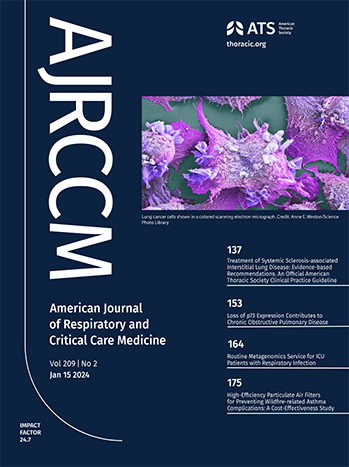非结核性分枝杆菌肺病的新基因位点及体重指数的潜在保护作用。
IF 19.4
1区 医学
Q1 CRITICAL CARE MEDICINE
American journal of respiratory and critical care medicine
Pub Date : 2025-09-12
DOI:10.1164/rccm.202406-1253oc
引用次数: 0
摘要
理由:尽管非结核分枝杆菌(NTM)广泛存在,但只有部分个体发生NTM-肺疾病(NTM- pd),提示宿主因素参与其中。目的鉴定NTM-PD的基因组结构,并确定NTM-PD与9种危险因素之间是否存在明确的关联。方法我们在两个独立的韩国队列中进行了全基因组关联研究,涉及1,949名NTM-PD患者和2,955名健康参与者。在日本(1137例,1546例对照)和欧洲(243例,570例对照)队列中分别验证了显著相关的遗传变异。通过定量性状位点分析等多种方法鉴定了与铅变异相关的基因,并通过单细胞转录组数据集支持了它们在NTM-PD中的作用。研究了NTM-PD与9个危险因素的遗传相关性和孟德尔随机化。我们鉴定了两个新的位点,并复制了一个与NTM-PD相关的位点:rs60084385(优势比(OR), 1.34;95%置信区间(CI), 1.21-1.48;P, 6.97×9);rs1479595 (OR, 1.40; 95% CI, 1.27-1.55; P, 7.08×10-11);rs194792 (OR, 1.70; 95% CI, 1.50-1.93; P, 1.39×10-16)。这些关联在独立队列中得到了重复。这三个位点分别与IL1Rs、PDE8B和PRKCB的表达水平显著相关,进一步证实了它们在NTM-PD发病机制中的作用。在危险因素中,只有体重指数与NTM-PD具有显著的遗传相关性(rg, -0.57;错误发现率[FDR], 1.33×10-5)和潜在的因果关系(OR, 0.38; 95% CI, 0.24-0.59; FDR, 8.55×10-5)。结论我们的研究发现了3个与NTM-PD相关的遗传位点,BMI与NTM-PD呈负相关。本文章由计算机程序翻译,如有差异,请以英文原文为准。
Novel Genetic Loci for Nontuberculous Mycobacterial Pulmonary Disease and Potential Protective Effect of Body Mass Index.
RATIONALE
Although nontuberculous mycobacteria (NTM) are widespread, only some individuals develop NTM-pulmonary disease (NTM-PD), suggesting the involvement of host factors.
OBJECTIVES
To identify the genomic structure of NTM-PD and determine whether a definitive association exists between NTM-PD and nine risk factors.
METHODS
We performed genome-wide association studies in two independent Korean cohorts involving 1,949 NTM-PD patients and 2,955 healthy participants. Significantly associated genetic variants were validated in Japanese (1,137 cases, 1,546 controls) and European (243 cases, 570 controls) cohorts, respectively. Genes associated with lead variants were identified using several methods including quantitative trait loci analyses and their roles in NTM-PD were supported by single-cell transcriptome datasets. Genetic correlations and Mendelian randomization between NTM-PD and nine risk factors were examined.
MEASUREMENTS AND MAIN RESULTS
We identified two novel loci and replicated a locus associated with NTM-PD: rs60084385 (odds ratio (OR), 1.34; 95% confidence interval (CI), 1.21-1.48; P, 6.97×10-9); rs1479595 (OR, 1.40; 95% CI, 1.27-1.55; P, 7.08×10-11); and rs194792 (OR, 1.70; 95% CI, 1.50-1.93; P, 1.39×10-16). These associations were replicated in the independent cohorts. The three loci were significantly associated with expression levels of IL1Rs, PDE8B, and PRKCB, respectively, whose involvement in the pathogenesis of NTM-PD were further validated. Among the risk factors, only body mass index demonstrated both a significant genetic correlation with NTM-PD (rg, -0.57; false discovery rate [FDR], 1.33×10-5) and a potential causal relationship (OR, 0.38; 95% CI, 0.24-0.59; FDR, 8.55×10-5).
CONCLUSIONS
Our study identified three genetic loci associated with NTM-PD and a negative association of BMI with NTM-PD.
求助全文
通过发布文献求助,成功后即可免费获取论文全文。
去求助
来源期刊
CiteScore
27.30
自引率
4.50%
发文量
1313
审稿时长
3-6 weeks
期刊介绍:
The American Journal of Respiratory and Critical Care Medicine focuses on human biology and disease, as well as animal studies that contribute to the understanding of pathophysiology and treatment of diseases that affect the respiratory system and critically ill patients. Papers that are solely or predominantly based in cell and molecular biology are published in the companion journal, the American Journal of Respiratory Cell and Molecular Biology. The Journal also seeks to publish clinical trials and outstanding review articles on areas of interest in several forms. The State-of-the-Art review is a treatise usually covering a broad field that brings bench research to the bedside. Shorter reviews are published as Critical Care Perspectives or Pulmonary Perspectives. These are generally focused on a more limited area and advance a concerted opinion about care for a specific process. Concise Clinical Reviews provide an evidence-based synthesis of the literature pertaining to topics of fundamental importance to the practice of pulmonary, critical care, and sleep medicine. Images providing advances or unusual contributions to the field are published as Images in Pulmonary, Critical Care, Sleep Medicine and the Sciences.
A recent trend and future direction of the Journal has been to include debates of a topical nature on issues of importance in pulmonary and critical care medicine and to the membership of the American Thoracic Society. Other recent changes have included encompassing works from the field of critical care medicine and the extension of the editorial governing of journal policy to colleagues outside of the United States of America. The focus and direction of the Journal is to establish an international forum for state-of-the-art respiratory and critical care medicine.

 求助内容:
求助内容: 应助结果提醒方式:
应助结果提醒方式:


